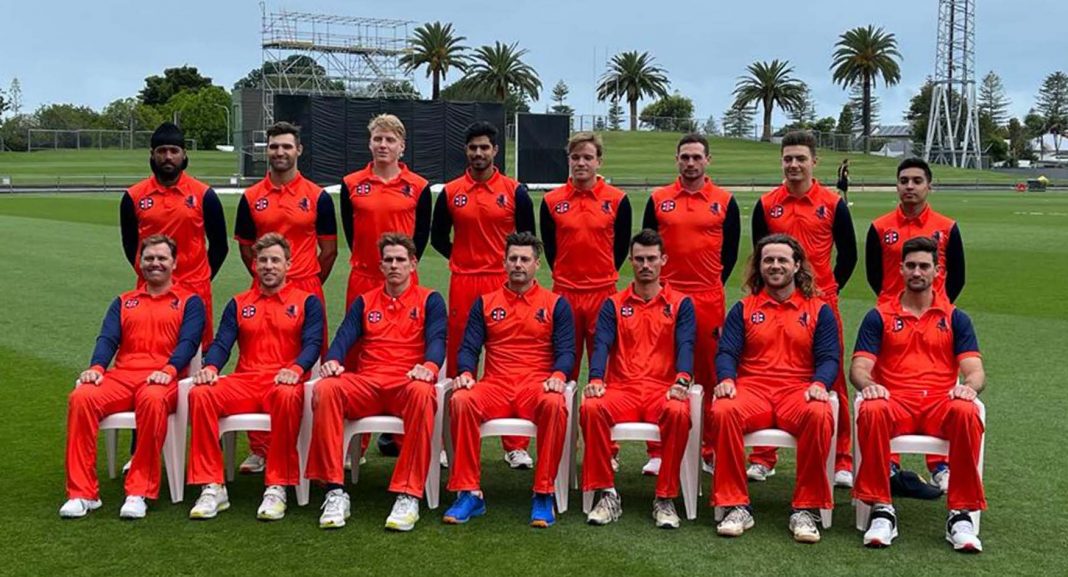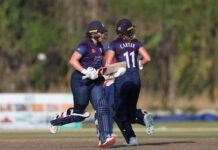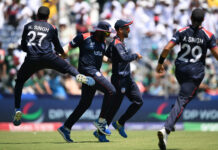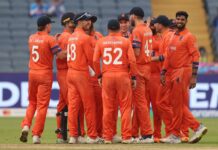How, one might reasonably ask, is it possible to reduce an opponent to 32 for five inside ten overs of an ODI and still lose by 118 runs?
The answer to the puzzle posed by Saturday’s Super League match at Seddon Park, Hamilton is complex: the most straightforward part is the contribution of New Zealand captain Tom Latham, who came to the crease at 30 for three and lost two partners in the space of two overs.
That the Blackcaps, officially the best ODI side in the world, found themselves in such a parlous condition was due to the Dutch new-ball pairing of Fred Klaassen and Logan van Beek, backed up by good catching and fed by some rash strokeplay by the home side’s top order.
But Latham batted throughout the rest of the innings with immaculate application, and stands of 57 with Colin de Grandhomme and 90 with Doug Bracewell, who contributed a 51-ball 41, gradually steered New Zealand away from complete disaster.
Once Klaassen and Van Beek were given a rest, with figures of two for 16 and three for 21 respectively from their six-over spells, the rebuilding process began, with none of the other Dutch bowlers finding the help from the conditions that the openers had.
Latham’s control of the situation is evident from the tempo of his innings: he took 62 deliveries to reach his half-century, just 39 more to go to three figures, and only another 22 to finish on an unbeaten 140, including two sixes and a four off Brandon Glover’s final three deliveries.
Even so, Latham seemed a little fortunate when, on 63, he was beaten by off-spinner Aryan Dutt, struck amidships trying to sweep, and ball-tracking judged that the ball would have been going over the stumps.
There was no doubt, however, about his second escape: three overs from the end, on 121, he holed out to mid-on off Klaassen, but immediately pointed out that Seelaar had a fielder too few inside the circle, and a no-ball was duly called. Nothing could have more graphically illustrated Latham’s complete command.
Michael Rippon and Seelaar himself contributed tidy spells, but it was Van Beek (four for 56) and Klaassen (three for 36) who took the bowling honours for the Dutch.
Having recovered to 264 for nine, however, New Zealand had the momentum on their side, and they carried it beyond the innings break when Kyle Jamieson and Doug Bracewell removed both Dutch openers within the first seven deliveries of the tourists’ reply.
Another top-order collapse was averted, though, by a spirited third-wicket stand of 77 between Vikram Singh and Bas de Leede, who hit a dozen boundaries between them and for a time raised hopes of a serious challenge to the Blackcaps’ bowling.
But the advent of leg-spinner Ish Sodhi into the attack changed the aspect of the game once more: Singh and De Leede were quite frankly bamboozled by his variations of turn and flight, and although it was De Grandhomme who secured the breakthrough, Singh hammering a full toss down the throat of Sodhi at long on and departing for 31, it was the leg-spinner’s guile which had set up the wicket.
And therein lies the crucial difference between these sides: however talented they may be, the Dutch don’t have anyone who can bat for the best part of 50 overs, anchoring the innings as Will Young did on Tuesday and as Latham did in this match.
True, the New Zealand bowlers, too, are a few degrees sharper, more disciplined and more menacing than their Dutch counterparts, but it is, as Pieter Seelaar himself readily acknowledges, the batting which repeatedly struggles at this level.
Lack of experience against top-quality opposition, the absence of a proper pathway from club cricket to the full glare of this international stage undoubtedly play their part, and this defeat once again underlines the severe disadvantages under which the leading Associates struggle to compete with their Full member opponents.
Once the Singh-De Leede partnership was broken much of the life went out of the Dutch reply: with the asking rate steadily rising and an air of desperation creeping in, wickets began to tumble: De Leede finally fell to Sodhi for 37, and thereafter only Rippon reached double figures, making 18 before Michael Bracewell beat him in the air as he came down the wicket and was stumped.
Bracewell’s off-spin complemented Sodhi superbly and he fully deserved his figures of three for 21, bowling Seelaar with a textbook delivery which turned prodigiously and then inducing an outside edge from Van Beek to Ross Taylor at slip.
It was all intensely disappointing from a Dutch point of view: Van Beek and Klaassen had given them the most triumphant hour in their 26-year ODI history, but the rest of the day, that brief interlude with Singh and De Leede apart, belonged to New Zealand, further underlining the gap between the two sides.
Seelaar’s men will need to muster all their character for Monday’s final match of the series.
You’re reading Emerging Cricket — brought to you by a passionate group of volunteers with a vision for cricket to be a truly global sport, and a mission to inspire passion to grow the game.
Be sure to check out our homepage for all the latest news, please subscribe for regular updates, and follow EC on Twitter, Facebook, LinkedIn and YouTube.
Don’t know where to start? Check out our features list, country profiles, and subscribe to our podcast.
Support us from US$2 a month — and get exclusive benefits, by becoming an EC Patron.







